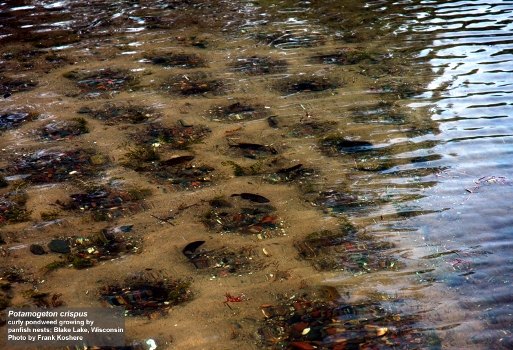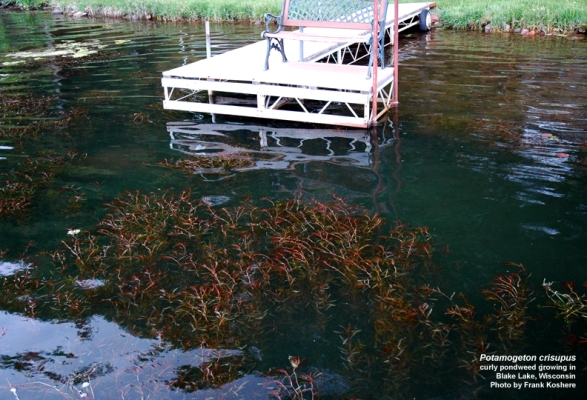Curly-Leaf Communities (Interactions)

Potamogeton crispus (along with other submerged plants) is responsible for creating a habitat that supports a vast underwater ecosystem.
Besides sheltering fish and other macroinvertebrates
that are common prey, these plants are responsible for
replenishing detritus that rests on the bottom of the lake
(known as the benthic zone). Also, curly leaf pondweed helps
to improve water quality by stabilizing sediments and
storing certain nutrients that are important for the lakes these incredible macrophytes reside in. Curly leaf pondweed
can also remove toxins such as phenol, cobalt, and cerium.
and
storing certain nutrients that are important for the lakes these incredible macrophytes reside in. Curly leaf pondweed
can also remove toxins such as phenol, cobalt, and cerium.
Curly leaf pondweed is often found to be in competitive relationships with coontail, water stargrass, and other pondweed species. This special species of underwater plant beats out its competitors by early turion formation (check out P. crispus reproduction); this adaptation allows the plant to beat competitors to the blocks as it begins growth earlier in the spring.

Potamogeton crispus is also a valiant and
selfless defender of macroinvertebrates who are mercilessly
preyed upon (okay, maybe not) by the vicious Lepomis
macrochirus-- more commonly known as the
bluegill--
pictured to the left. Curly leaf pondweed provides adequate
shelter (and a nutritious food source) for many organisms
such as
caddisflies,
damselflies, beetles, dragonfly nymphs,
and midge larvae. Other predators of these organisms that
frequently hunt near beds of curly leaf pondweed include the
veracious
largemouth bass and the unimaginably inhumane
black crappie.
 Curly leaf pondweed is also very important in
increasing the diversity of habitats and resources
for macroinvertebrate species. Many studies have
concluded that there is a positive
relationship between the activity of submerged
plants and the abundance of fish and other organisms
in lakes! By affecting the light, local temperature,
and oxygen concentration, Potamogeton crispus
influences many ecosystems. The tissues of these
incredible organisms can also be important parts of
diets to many herbivores like ducks and coots!
Curly leaf pondweed is also very important in
increasing the diversity of habitats and resources
for macroinvertebrate species. Many studies have
concluded that there is a positive
relationship between the activity of submerged
plants and the abundance of fish and other organisms
in lakes! By affecting the light, local temperature,
and oxygen concentration, Potamogeton crispus
influences many ecosystems. The tissues of these
incredible organisms can also be important parts of
diets to many herbivores like ducks and coots!
Continue on to read about ecological control of this invasive species!